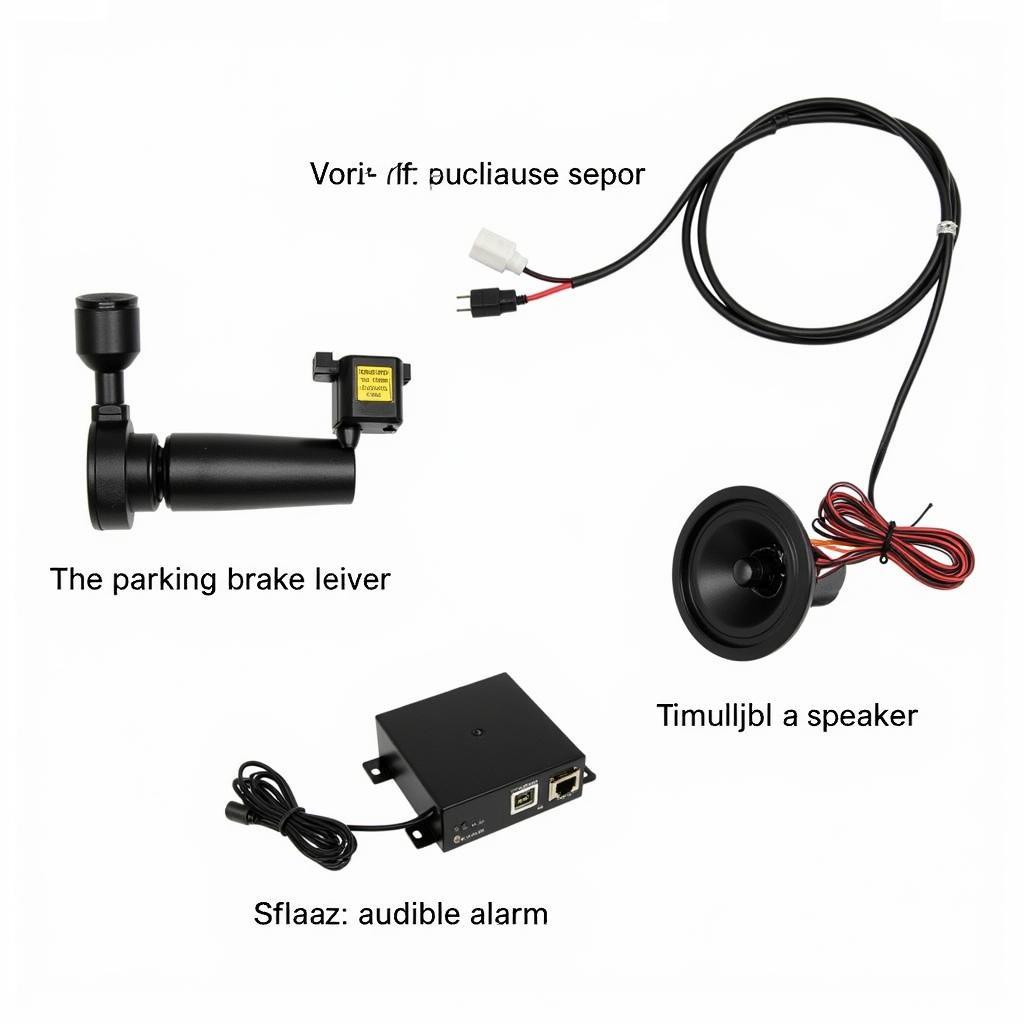When it comes to vehicle safety, a properly functioning parking brake is crucial. While factory-installed systems are generally reliable, many car owners opt for aftermarket parking brake warning systems for added peace of mind. These systems provide an extra layer of safety by alerting the driver if the parking brake is engaged while the vehicle is in motion. This guide explores everything you need to know about aftermarket parking brake warning systems, from understanding their benefits to installation and troubleshooting.
Understanding Aftermarket Parking Brake Warning Systems
An aftermarket parking brake warning system acts as an independent safety mechanism, working in tandem with your vehicle’s existing parking brake system. Typically consisting of a sensor, a control unit, and an audible alarm, these systems are designed to detect when the parking brake is engaged and the vehicle is in motion.
 Aftermarket Parking Brake Warning System Components
Aftermarket Parking Brake Warning System Components
Why Choose an Aftermarket System?
While most modern vehicles come equipped with basic parking brake warning lights, these often only illuminate when the parking brake is partially engaged. An aftermarket system offers a more comprehensive approach:
- Enhanced Safety: Provides a clear and immediate audible warning, minimizing the risk of accidents caused by driving with the parking brake engaged.
- Prevent Costly Damage: Driving with the parking brake on can lead to overheating brakes, premature wear and tear, and even damage to the transmission. An aftermarket system can help avoid these costly repairs.
- Increased Awareness: Serves as a constant reminder to disengage the parking brake, promoting safer driving habits.
Types of Aftermarket Parking Brake Warning Systems
The market offers a range of systems to choose from, each with its own set of features and installation processes. Some common types include:
1. Switch-Activated Systems
These systems utilize a simple on/off switch that is integrated with the parking brake lever. When the parking brake is engaged, the switch activates the alarm.
2. Sensor-Based Systems
More sophisticated sensor-based systems employ various sensor technologies, such as:
- Motion Sensors: Detect vehicle movement and trigger the alarm if the parking brake is engaged.
- Speed Sensors: Activate the alarm once the vehicle exceeds a predetermined speed, indicating the parking brake is likely still on.
Installation: DIY or Professional?
Installation complexity varies depending on the system and your vehicle’s make and model.
DIY Installation:
- Switch-activated systems are generally easier to install, often requiring basic wiring connections.
- Sensor-based systems can be more complex, requiring precise sensor placement and potentially more intricate wiring.
 Installing a Parking Brake Warning System
Installing a Parking Brake Warning System
Professional Installation:
- If you’re uncomfortable with automotive wiring or unsure about the installation process, seeking professional help is always recommended.
- A certified mechanic can ensure the system is properly installed and integrated with your vehicle’s electrical system.
Troubleshooting Common Issues
While generally reliable, you might encounter issues with your aftermarket parking brake warning system:
- False Alarms: If the alarm activates when the parking brake is disengaged, it could indicate a faulty sensor, a wiring issue, or a problem with the control unit.
- No Alarm: If the alarm fails to sound when the parking brake is engaged, check the wiring connections, the sensor, and ensure the control unit is receiving power.
For more specific troubleshooting information on brake warning systems, refer to our guides:
Choosing the Right System for Your Vehicle
Selecting the appropriate aftermarket parking brake warning system depends on several factors:
- Vehicle Type: Consider your vehicle’s make, model, and year when choosing a system, as compatibility can vary.
- Budget: Systems range in price based on complexity and features. Determine your budget and weigh it against the level of safety and features you require.
- Installation: Assess your DIY skills or factor in the cost of professional installation.
Expert Insight
“An often overlooked aspect of vehicle safety is the humble parking brake. While drivers are generally aware of its function, many underestimate the potential risks associated with driving with it engaged,” says automotive engineer Sarah Thompson. “Investing in an aftermarket parking brake warning system provides an additional layer of protection, acting as a crucial reminder and potentially preventing accidents and costly damage.”
Conclusion
An aftermarket parking brake warning system is a valuable investment in safety and peace of mind. By providing a clear and timely warning, these systems mitigate the risks associated with driving with the parking brake engaged. Whether you choose a simple switch-activated system or a more advanced sensor-based option, remember to prioritize proper installation and familiarize yourself with the system’s features and operation. By doing so, you contribute to a safer driving experience for yourself and others on the road.

